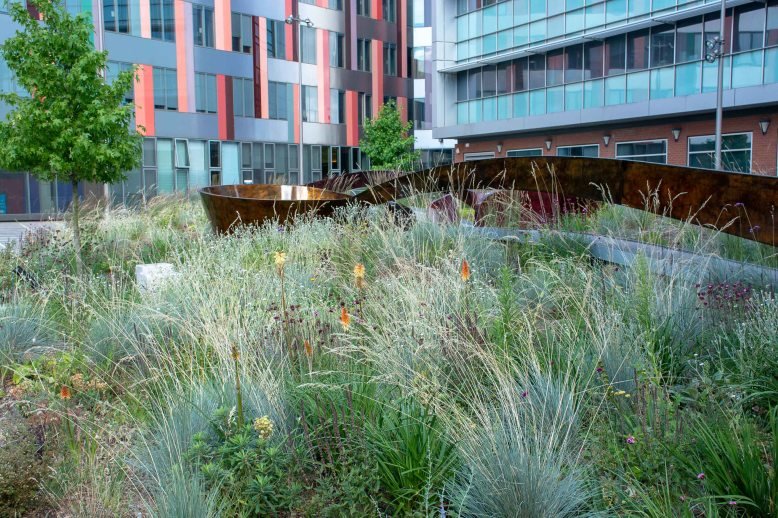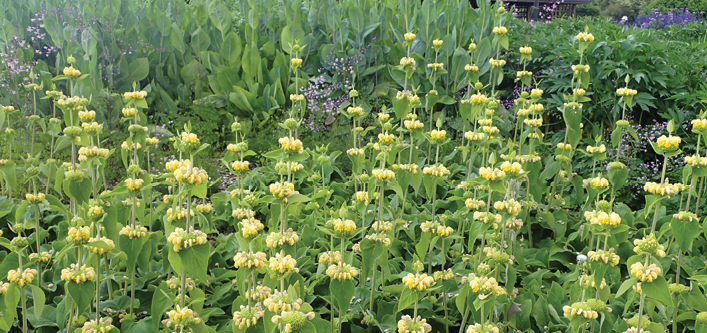Garden of Pooled Talents
Description of the Garden, the impetus for the design and the symbolism contained within it
The Garden of Pooled Talents is a public art work on the University of Sheffield campus, that sits in a courtyard space between the Diamond Building (Engineering School) and the Jessop West Building (Arts and Humanities). The large galvanized metal structures represent giant ladles reaching out from both sides, with central gathering spaces symbolizing the meeting of the disciplines.
This is a podium deck landscape (i.e hard surface underneath rather than soil) and is not irrigated. There is a strong landform of ‘ripples’ that move out from the center, and the plants are growing in a free-draining, aggregate-based green roof substrate.
The concept and design for this project came from the artist Stephen Broadbent and was carried out by Broadbent studio. The studio website describes that Stephen Broadbent “has over the last thirty years successfully completed many public art projects, demonstrating a role where artists can be radically engaged in the community, finding solutions, selecting and interpreting themes that enlarge, enliven and enlighten our experience of the world.” The group is described as follows: “WE ARE AN EXPERIENCED TEAM OF ARTISTS, DESIGNERS AND ENABLERS THAT RESPOND IMAGINATIVELY TO PLACE AND PEOPLE. We conceive and champion public art and design projects in collaboration with architects and urban designers, allowing a community to become active participators in a process of change, celebration or remembrance. The studio facilitates creative engagement projects, developing specific strategies and frameworks for cultural activities and creative intervention. We are also a studio of makers, with an equipped workshop, and proven relationships with manufacturing partners, that enable us to not just conceive ideas but to also craft elements large and small that are site specific and beautifully integrated into their environment.”
https://broadbent.studio/garden-of-pooled-talents
Pictures of the construction process shown below are are from Broadbent Studio and words are from Stephen Broadbent.
This is how the project is described on the Broadbent studio website:
The original brief was to design concrete planters for a rather forlorn left-over space between … a new building, designed by Twelve Architects, and the equally distinctive geometric Jessop West Humanities building, designed by Sauerbruch Hutton. The space is also partly enclosed by the Music School housed in the original Gothic grade II Jessop building and the glazed facade of the landmark bio incubator building.
These surrounding buildings presented both a challenge and an opportunity that resulted in the inspiration for our conceptual idea and a determination to create a remarkable space that could unite these building and their particular use.
Our site was the misshapen area left between buildings that don’t talk to each other.
It was bleak, hemmed in, and unwanted.
Greenery needed to break it up, soften, bring life to this space in the same way greenery is being encouraged to invigorate the built environment all over Sheffield. But nature is not reclaiming the city by itself; humans are helping. …
These thoughts gave us the image of a garden into which humans are pouring water, and which seems to be growing outwards.
Students from both sides of the old arts and sciences divide need to enliven the society they share by pooling different ways of seeing the world. The society they share is a garden and an exchange of ideas produces a flowering - a garden that grows.
LADLES TO BRING WATER
Twin paths draw people from opposite sides of a garden, to twin seating areas in the middle. Two giant metal ladles pour water into the ground. Ladle-sculptures give a nod to Sheffield’s cutlery-making tradition, particularly the craftsmanship of the Little Mesters.
A MARRIAGE OF ART & SCIENCE
The ladles seem to pour water, but what they actually feed the garden with are students from both sides of a traditional divide - one ladle brings the arts students, the other brings the science students.
Arts and sciences represent different approaches to investigating the world, but both are expressions of the same creative impulse in humans. Both ladles are identical in form and material, but each has a different finish.
The central paving holds two sequences of words that reveal contrasting processes of thought, one drawn from a more analytical scientific process, and the other from a more creative perspective representing the arts. Each ends with the word Share, and throughout their differing sequence, there are words that are common to both processes.
RIPPLES GROWING EVER OUTWARDS
At the centre of the garden lies a small circle - a drop of water poured from twin ladles, a drop of inspiration produced from the sharing of ideas.
Outwards from this central circle spread ripples - concentric rings of hard surface and planting, followed by ripples in the landform. The movement of these ripples out from the centre has left the garden with a ragged outer edge creeping into the existing paving.
OUTCROPS OF GROWTH
Near the perimeter of the garden, trees have taken root. Our concept also included, further out, smaller secondary areas of greenery, bringing with them more trees. Each of these outcrops of growth is fringed by its own creeping edge.
The garden seems to be spreading out of the site like lichen colonising a rock-face.
MAKING
Galvanised steel with a decorative lacquered finish was the chosen material. The decking of the bridge sections consist of a bound aggregate and the central area infilled with concrete and a bonded aggregate finish. The poem was carved in contrasting limestone.
The landform was created from a lightweight substrate often used on flat roofs, with good properties of water retention. The planting scheme was designed by Professor Nigel Dunnett and planted by the in-house landscape team.
The steelwork was fabricated and installed by Chris Brammall Ltd.
Nigel Dunnet’s Planting Design
There are two main plant mixes. The larger area is a ‘steppe’ type mix for dry open sun, and there is also a smaller area of more shade-tolerant plants for parts of the site that are in shade for most of the day.
The main planting consists of a structural framework of matrix of the Blue Oat Grass, Helicotrichon sempervierens with blue/grey leaves and arching fountains of flowers in early summer. The evergreen Euphorbia characias subsp wulfenii plays a prominent role, especially in winter and spring. Kniphofia ‘Green Jade’ is prominent in late summer and autumn with blue Aster x frikartii ‘Monch’. All these plants are arranged as a naturalistic mixture, with larger groupings of yellow-flowered Phlomis russeliana – which also has excellent autumn and winter seed heads. Amongst these structural plants, a mix of seasonal perennials creates a successional display from spring through to autumn.
Key plants
Blue Oat Grass
Euphorbia characias subsp wulfenii ‘Humpty Dumpty’
Aster x frikartii ‘Monch’
Kniphofia ‘Green Jade’
Phlomis russeliana
Shadier parts of the garden
In the areas which have more shade, the tall upright grass Calamagrostis ‘Overdam’ creates graceful vertical accents. White aqulegia fills the spaces between in the spring, and in summer through to autumn, white Anemone x hybrida ‘Honorine Jobert’ and Eupatorium ‘Purple Bush’ are prominent.
Key plants
Calamagrostis ‘Overdam’
Aquilegia vulgaris ‘Nivea’
Anemone X hybrida ‘Honorine Jobert’
Eupatorium ‘Purple Bush’
Geranium sylvaticum ‘Mayflower’
Euphorbia and Geranium





















